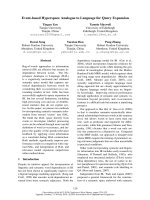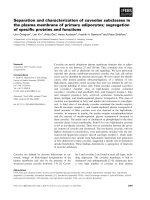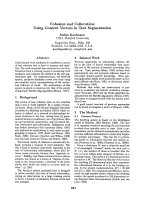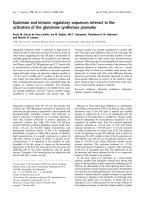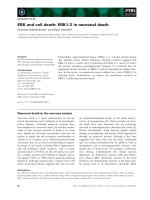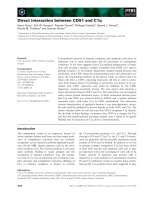báo cáo khoa học: "Direct and correlated responses to selection for and small 6-week body weight in mice" pps
Bạn đang xem bản rút gọn của tài liệu. Xem và tải ngay bản đầy đủ của tài liệu tại đây (523.44 KB, 13 trang )
Direct
and
correlated
responses
to
selection
for
large
and
small
6-week
body
weight
in
mice
Yolanda BAYON,
L.F.
FUENTE
F.
SAN
PRIMITIVO
Departamento
de
Produceión
Animal,
Universidad
de
Le6n,
Le6n,
Spain
Summary
A
selection
experiment
based
on
individual
performance
for
large
(W
+)
and
small
(W-)
6-week
body
weight
was
conducted
for
15
generations
in
mice.
A
3rd
line,
C,
was
maintained
as
an
unselected
control.
Direct
responses
measured
as
deviations
from
the
control
line
were
similar
in
W+
(10.63
g)
and
W-
(-
9.23
g).
Realized
heritabilities
for
6-week
weight
were
0.27
±
0.02
in
W+,
0.29
±
0.02
in
W-
and
0.28
±
0.01
for
divergence.
Correlated
responses
for
3-week
body
weight
did
not
show
asymmetry,
the
corresponding
values
being
3.42
g
and -
3.81
g
for
upward
and
downward
selection,
respectively.
Realized
genetic
correlations
were
0.96 ±
0.03
between
6-week
and
3-week
weight
and
0.50
±
0.01
between
6-week
weight
and
3-6
week
gain.
Litter
size
at
1st,
2nd
and
3rd
parity
was
hardly
modified
in
the
upward
selection
(W
+)
whereas
it
was
considerably
reduced
in
the
downward
selection
(W-).
Realized
genetic
correlations
estimated
from
the
divergence
were
0.21
±
0.07
between
6-week
weight
and
first
litter
size
and
0.29
±
0.04
between
6-week
weight
and
the
total
number
of
young
born
in
the
first
3
births
(TNY-3).
Key
words :
Mice,
body
weight,
selection,
litter
size.
Résumé
Réponses
directe et
corrélée
à
une
sélection
divergente
sur
le
poids
corporel
à
l’âge
de
six
semaines
chez
la
souris
Une
expérience
de
sélection
divergente
sur
le
poids
individuel
à
l’âge
de
6
semaines
a
été
conduite
pendant
15
générations
chez
la
souris
(lignée
haute :
W+,
lignée
basse :
W-).
Une
3’
lignée
non
sélectionnée
(C)
a
été
maintenue
comme
témoin.
Les
réponses
directes
mesurées
en
déviations
par
rapport
à
la
lignée
témoin
sont
similaires
dans
les
lignées
W+
(10,63
g)
et
W-
(-
9,23
g).
Les
héritabilités
réalisées
du
poids
à
6
semaines
sont
de
0,27
±
0,02
dans
la
lignée
W+,
0,29
±
0,02
dans
la
lignée
W-
et
0,28
±
0,01
pour
la
divergence.
Les
réponses
corrélées
sur
le
poids
corporel
à
l’âge
de
3
semaines
ne
présentent
pas
d’asymétrie,
les
valeurs
correspondantes
étant
respectivement
de
3,42
g
et -
3,81
g
dans
les
lignées
haute
et
basse.
Les
corrélations
génétiques
réalisées
sont
de
0,96
±
0,03
entre
les
poids
à
6
et
3
semaines
d’âge
et
de
0,50
±
0,01
entre
le
poids
à
6
semaines
et
le
gain
3-6
semaines.
La
taille
de
portée
à
la
1",
2’
et
3<
mise
bas
est
à
peine
modifiée
dans
la
lignée
haute
(W
+
),
alors
qu’elle
est
considérablement
réduite
dans
la
lignée
basse
(W-).
Les
corrélations
génétiques
réalisées,
estimées
à
partir
de
la
divergence,
sont
de
0,21
±
0,07
entre
le
poids
à
6,
semaines
et
la
taille
de
la
1"
portée
et
de
0,29
±
0,04
entre
le
poids
à
6
semaines
et
le
nombre
total
de
jeunes
nés
lors
des
3
premières
mises
bas
(TNY-3).
Mots
clés :
Souris,
poids
corporel,
sélection,
taille
de
portée.
I.
Introduction
Body
weight
is
a
trait
of
considerable
importance
that
has
been
intensely
studied
in
laboratory
animals.
Selection
for
body
weight
in
mice
has
generally
led
to
a
substantial
direct
response
(see
reviews
by
E
ISEN
,
1974
and
MCC
ARTHY
,
1982).
The
possibility
of
improving
litter
size
following
selection
for
increased
body
weight
has
been
frequently
considered.
However
results
are
variable :
an
increase
in
litter
size
has
been
described
(Ets
E
rr
et
al.,
1973 ;
E
ISErr,
1978)
while
in
some
cases
no
change
became
evident
(BRADFORD,
1971 ;
BARRIA
&
BRADFORD,
1981).
A
two
way
selection
experiment
for
large
and
small
6-week
body
weight
was
performed
for
15
generations.
The
objective
of
this
experiment
was
to
evaluate
the
changes
that
appear
both
in
weight
and
reproduction
traits
following
divergent
selection
for
body
weight.
II.
Materials
and
methods
Mice
used
in
the
present
experiment
were
obtained
from
a
randombred
population
which
was
divided
into
3
lines :
W+,
C
and
W
Lines
W+
and
W-
were
selected
on
the
basis
of
individual
performance
for
large
and
small
6-week
body
weight,
respectively.
Line
C
was
maintained
as
an
unselected
control.
Selection
was
performed
over
15
generations.
The
lines
were
reproduced
from
50
mating
pairs
in
each
generation
for
generations
1-8
and
40
mating
pairs
for
generations
9-15,
that
change
being
caused
by
limitations
in
the
animal
house.
Males
and
females
were
pair-mated
randomly
at
50-60
days
of
age
with
avoidance
of
full-sib
mating.
Standardization
of
litter
size
to
8
mice
was
performed
at
2
days
of
age
in
order
to
reduce
the
maternal
effect.
Selection
was
practised
on
first
litter
progeny.
No
overlapping
of
generations
occurred.
The
following
data
were
recorded :
-
individual
body
weight
at
3
and
6
weeks
of
age ;
-
litter
size
(number
of
live
young
born)
at
1st,
2nd
and
3rd
parity ;
-
number
of
fertile
matings,
measured
as
the
number
of
females
having
the
litter
within 15
days
of
birth
of
the
first.
Details
of
the
breeding
procedures
as
well
as
results
obtained
up
to
generation
8
have
been
previously
described
(F
UENTE
&
S
AN
P
RIMITIVO
,
1985).
Realized
heritability
was
calculated
as
direct
response
regressed
on
cumulative
selection
differential.
Realized
genetic
correlation
between
2
traits
was
calculated
using
the
formula
of
R
UTLEDGE
et
al.
(1973) :
rcir !
b
CR/R
(hx
QP
xI hy
U
IY
)
where
b
CR/R
is
the
realized
genetic
regression
of
correlated
response
in
trait
«
y
» on
direct
response
in
trait
«
x
».
Standard
errors
of
hz,
and
r!!
were
based
on
the
formulae
presented
by
HILL
(1971).
III.
Results
Six
week
body
weights
for
generations
1-15
of
lines
W’,
C
and
W-
are
depicted
in
figure
1,
the
values
used
for
the
graphs
being
the
average
of
male
and
female
means.
Standard
errors
of
the
means
are
also
depicted
for
the
selected
lines.
The
difference
between
the
W+
and
W-
lines
increased
gradually
and
reached
its
maximum
in
generation
15.
A
decline
in
the
selected
and
control
lines
was
observed
possibly
due
to
environmental
effects.
After
15
generations
of
selection,
6-week
body
weight
in
the
line
W+
(43.21
g)
nearly
doubled
that
of
line
W-
(23.35
g).
The
inbreeding
coefficient
was
estimated
from
genealogical
data
until
generation
13,
showing
a
small
increase
with
generations.
Estimates
were
based
on
the
common
ancestors
of
5
generations
for
each
individual.
The
base
population
was
considered
generation
0.
After
13
generations
of
selection
the
average
inbreeding
coefficient
was
2.83
p.
100,
3.63
p.
100,
and
1.22
p.
100
in
the
W+,
W-
and
C
lines.
The
average
increase
per
generation
was
0.22
p.
100,
0.28
p.
100
and
0.09
p.
100
in
W‘,
W-
and
C,
respectively.
A.
Selection
differential
Realized
selection
differentials
(SDr)
for
upward
and
downward
selection
for
generations
1-15
are
shown
in
table
1.
SDr
per
generation
were
quite
constant
through
all
the
experiment,
the
values
being
higher
in
W+
than
in
W
Cumulative
selection
differential
was
37.29
g
in
W+
and —
30.46
g
in
W-
after
15
generations
of
selection.
The
average
SDr
estimated
from
divergence
was
4.5
g
per
generation.
Expected
selection
differential
(SDe)
in
W+
(37.53
g)
was
nearly
equal
to
realized
selection
differential.
On
the
contrary
SDe
in
W-
(-
32.53
g)
showed
a
larger
value
than
SDr.
B.
Direct
response
and
realized
heritability
Direct
responses
(R)
to
selection
for
6-week
body
weight
in
W+
and
W-
are
given
in
table
1.
After
15
generations
of
selection
the
cumulative
response
estimated
as
deviation
from
the
control
line
was
10.63
g
for
upward
selection
and
9.23
g
for
downward
selection.
Response
calculated
from
divergence
plotted
against
cumulative
selection
differential
is
depicted
in
figure
2.
Realized
heritability
was
estimated
in
2
different
periods
(generations
1-8
and
generations
9-15),
the
corresponding
values
being
presented
in
table
2.
Estimates
of
h’,
in
W+
for
generations
9-15
showed
an
increase
in
comparison
with
generations
1-8
(F
UENTE
&
S
AN
P
RIMI
TIVO
,
1985).
On
the
contrary,
h!
in
W-
declined
in
the
second
period
relative
to
the
previous
generations.
However
differences
did
not
reach
statistical
significance.
Realized
heritability
estimated
from
the
divergence
for
generations
1-15
was
0.28
±
0.01,
which
did
not
differ
significantly
from
the values
obtained
in
the
separate
periods
(0.29
±
0.01
in
generations
1-8
and
0.30 ±
0.01
in
generations
9-15).
C.
Correlated
responses
to
selection
1.
Growth
traits
Weaning
weight
(3-week)
as
well
as
3-6
week
gain
were
modified
as
a
result
of
selection for
6-week
body
weight.
Partition
of
6-week
body
weight
means
into
the
2
components
(3-week
weight
and
3-6
week
gain)
for
the
W*,
C
and
W-
lines
in
generation
15
is
shown
in
figure
3.
At
the
end
of
the
selection
process
3-week
body
weight
means
were
17.38
g
and
10.15
g
in
the
W+
and
W-
lines,
respectively.
Cumulative
responses
estimated
as
deviations
from
the
C
line
were
3.42
g
in
W+
and —
3.81
g
in
W
Thus,
after
15
generations
of
selection
the
magnitude
of
changes
in
3-week
weight
was
similar
in
the
high
and
low
lines,
whereas
results
obtained
up
to
generation
8
(FuErrTE
&
S
AN
P
RIMITIVO
,
1985)
had
shown
a
larger
response
in
W-
than
in
W+.
Postweaning
gain
in
generation
15
was
25.83
g
in
the
W+
line
and
13.20
g
in
the
W-
line.
Cumulative
response
measured
as
deviation
from
the
control
line
was
higher
in
W+
(7.21
g)
than
in
W-
(-
5.42
g).
Realized
genetic
correlations
estimated
for
the
growth
traits
were
high
(0.96
±
0.03
between
6-week
and
3-week
weight
and
0.50
±
0.07
between
6-week
weight
and
3-6
week
gain).
2.
Reproduction
Correlated
responses
in
litter
size
for
each
parity
estimated
from
the
divergence
are
summarized
in
table
3.
After
15
generations
of
selection
correlated
response
in
the
total
number
of
young
born
in
the
first
3
births
(TNY-3)
was
14.85
mice,
the
corresponding
values
for
each
parity
being
5.6,
5.23
and
4.48
mice
for
the
1st,
2nd and
3rd
litter
size,
respectively.
The
means
of
the
first
litter
sizes
in
W+
and
W-
deviated
from
the
control
line
are
graphed
for
generations
1-15
in
figure
4.
Changes
in
1st
litter
size
following
selection
for
6-week
body
weight
were
much
larger
in
the
W-
line
(-
4.85
mice)
than
in
the
W+
line
(0.75
mice).
Actually,
changes
in
W+
measured
as
deviations
from
the
C
line
over
generations
did
not
reach
statistical
significance.
The
average
number
of
young
born
in
the
first
3
births
(TNY-3)
over
generations
for
the
W+,
C
and
W-
lines
are
depicted
in
figure
5.
A
decline
in
TNY-3
was
observed
in
the
control
and
the
selected
lines
through
all
the
experiment
(as
already
pointed
out
for
body
weight).
Correlated
response
in
TNY-3
followed
rather
closely
that
of
1st
litter
size.
Little
change
was
detected
in
the
Wl
line
for
TNY-3
whereas
a
large
decline
was
found
in
W
Nevertheless
changes
in
Wl
for
TNY-3
were
statistically
significant
(P
<
0.05).
Realized
genetic
correlation
calculated
between
6-week
body
weight
and
the
1st
litter
size
was
not
high
(0.21
±
0.07),
the
values
obtained
for
the
2nd
and
3rd
litter
size
and
TNY-3
reaching
a
similar
level
(table
4).
The
values
obtained
for
W+
and
W-
separately
showed
a
pronounced
asymmetry.
Realized
genetic
correlation
between
6-
week
weight
and
the
1st
litter
size
was
0.03
±
0.07
in
W’
(not
significantly
different
from
zero)
and
0.42
±
0.06
in
W-,
the
corresponding
values
between
6-week
weight
and
TNY-3
being
0.15
±
0.04
in
W+
and
0.43
±
0.04
in
W
The
percentage
of
fertile
matings
maintained
a
similar
level
(with
some
fluctua-
tions)
through
generations
1-13
(figure
6).
The
average
value
per
generation
was
88.4
p.
100
in
W+
and
88.4
p.
100
in
W
However
line
W+
showed
a
sharp
decrease
in
generations
14
and
15,
whereas
no
change
was
observed
in
the
low
line.
The
percen-
tage
of
fertile
matings
measured
in
generation
15
was
60
p.
100
in
W+
and
88
p.
100
in
W
IV. Discussion
A.
Selection
differential
Realized
selection
differential
in
W+
was
higher
than
that
of
W-,
in
agreement
with
the
results
obtained
generally
following
divergent
selection
for
body
weight
(FALCONER,
1953,
1973 ;
LEGATES,
1969).
That
effect
was
mostly
due
to
differences
in
viability
of
young
born
and
litter
size
between
the
W+
and
W-
lines.
Those
differences
caused
the
SDe
to
be
larger
in
the
high
line
than
in
the
low
line.
Moreover
SDr
was
lower
than
SDe
in
W-,
while
no
differences
appeared
in
W+.
The
decreased
litter
size
of
the
smaller
mice
resulted
in
differences
among
the
females
selected
in
W-
with
regard
to
their
contribution
to
the
SDr.
That
effect
was
not
important
during
the
1st
period
(generations
1-8)
because
of
the
standardization
of
litter
size.
Thereafter
mean
litter
size
was
considerably
reduced
in
W-
and
a
large
number
of
families
had
fewer
than
8
mice
per
litter.
On
the
contrary,
standardization
of
litters
allowed
an
equal
contribution
to
the
following
generation
for
all
females
selected
in
W+.
A
reduction
in
the
percentage
of
fertile
matings
in
the
low
line
compared
with
the
high
line
has
been
described
in
some
cases
(LEGATES,
1969 ;
FALCONER,
1973)
contribut-
ing
to
the
difference
in
selection
differentials.
However,
the
percentage
of
fertile
matings
was
similar
in
W+
and
W
Only
in
generations
14
and
15
was
a
clear
difference
detected
between
the
lines,
the
percentage
of
fertile
matings
being
lower
in
W+
than
in
W
B.
Direct
response
Direct
response
to
individual
selection
for
6-week
body
weight
in
the
W+
and
W-
lines
was
high,
in
agreement
with
the
general
finding
that
much
of
the
variation
in
body
weight
has
an
additive
genetic
base.
Realized
heritability
estimated
for
the
divergence
in
generations
1-8
(0.28
±
0.01)
did
not
significantly
differ
from
that
calculated
in
generations
9-15
(0.30
±
0.01).
These
values
may
be
considered
in
agreement
with those
found
in
several
selection
experi-
ments
for
high
and
low
body
weight
(FALCONER,
1953,
1973 ;
LEGATES,
1969 ;
BUTLER
et
al.,
1984).
Magnitude
of
response
maintained
the
same
level
through
all
the
experiment,
and
no
decline
was
detected
in
the
later
generations.
The
difference
between
the
W+
and
W-
lines
after
15
generations
of
selection
amounted
to
59
p.
100
of
the
base
population
weight,
that
value
being
comparable
to
that
found
by
FALCONER
(1953)
after
11
genera-
tions
of
selection
(50
p.
100).
FALCONER
(1953)
and
LEGATES
(1969)
found
a
higher
response
in
the
downward
selection,
compared
with
upward
selection
caused
by
the
asymmetric
change
obtained
in
weaning
weight.
On
the
contrary
results
of
FALCONER
(1973)
and
BUTLER
et
al.
(1984)
did
not
show
significant
differences
between
directions
of
selection.
Response
in
W+
(10.63
g)
exceeded
somewhat
that
of
W-
(9.23
g),
in
contrast
with
the
results
obtained
in
generations
1-8
(FuErrTE
&
S
AN
P
RIMITIVO
,
1985).
The
higher
response
obtained
in
W+
compared
to
W-
seems
to
be
caused
by
the
difference
in
SDr
since
the
realized
heritability
in
W-
(0.29
±
0.02)
exceeded
that
of
W+
(0.27
±
0.02)
although
the
difference
was
not
significant.
C.
Correlated
response
1.
Growth
traits
Selection
for
body
weight
seems
to
accelerate
the
normal
processes
of
cellular
growth
(M
CC
ARTHY
,
1980)
which
explains
the
change
generally
detected
in
body
weight
at
different
ages
as
a
result
of
selection
for
weight
at
a
fixed
age
(R
UTLEDGE
et
al.,
1973 ;
E
ISEN
,
1978).
Weaning
weight (3-week)
and
3-6
week
gain
were
modified
in
the
W+
and
W-
lines
in
agreement
with
expectations.
Realized
genetic
correlations
between
6-week
weight
and 3-week
weight
or
3-6
week
gain
were
high
and
similar
to
those
obtained
in
comparable
experiments
(E
ISEN
,
1978 ;
BAKER
et
al.,
1984).
However,
the
value
calculated
between 3-week
and
6-week
weight
seems
to
be
an
overestimate
since
the
correlated
response
obtained
in
3-week
weight
following
selection
for
6-week
body
weight
is
mostly
caused
by
the
maternal
effect
(E
ISEN
,
1972).
FALCONER
(1953)
and
LEGATES
(1969)
had
demonstrated
a
larger
correlated
response
for
3-week
weight
in
the
low
line
relative
to
the
high
line.
That
effect
was
explained
assuming
that
weaning
weight
was
mostly
determined
by
the
mothering
ability
which
is
a
component
of
natural
fitness
and
thus
expected
to
be
lowered
in
both
directions
of
selection.
However
FALCONER
(1973)
did
not
find
significant
differences
between
upward
and
downward
selection.
In
our
experiment,
correlated
response
in
3-week
weight
was
very
close
for
upward
and
downward
selection
after
15
generations,
in
contrast
with
the
results
obtained
in
the
first
8
generations,
which
demonstrated
a
higher
response
in
W-
than
in
W+.
However,
when
that
response
was
measured
relative
to
the
increase
in
selection
differential,
it
was
larger
in
the
low
line
than
in
the
high
line
(0.12
g
in
W-
and
0.09
g
in
WI
).
Besides,
the
asymmetry
may
have
been
partly
obscured
in
our
experiment
by
the
decreased
survival
of
smaller
mice
which
possibly
resulted
in
an
increase
in
milk
supply
to
the
fewer
offspring.
The
apparent
asymmetric
response
found
in
postweaning
gain
was
partially
the
result
of
a
difference
in
selection
differentials
between
W+
and
W
When
that
correlated
response
was
estimated
per
unit
of
selection
differential,
correlated
responses
were
nearly
equal
in
W’
(0.19
g)
and
W-
(0.18
g).
2.
Reproduction
Selection
for
6-week
body
weight
resulted
in
a
clear
differentiation
in
1st
litter
size
between
the
W+
and
W-
lines,
in
agreement
with
the
results
obtained
in
several
experiments
with
mice
(FALCONER,
1953 ;
F
OWLER
&
E
DWARDS
,
1960 ;
LEGATES,
1969).
Changes
in
1st,
2nd
and
3rd
litter
size
were
large
in
the
W-
line,
but
small
in
the
W+
line.
As
a
result
a
marked
asymmetry
was
detected
in
the
realized
genetic
correlation
estimated
in
W+
and
W-
separately.
On
the
other
hand,
a
high
correlated
response
in
first
litter
size
was
obtained
in
some
selection
experiments
in
which
body
weight
was
improved
(E
ISEN
et
al.,
1973 ;
E
ISEN
,
1978).
The
weak
increase
in
litter
size
detected
in
W+
may
have
been
partially
caused
by
the
large
average
litter
size
of
our
base
population
(11.35,
12.59
and
12.62
mice
at
1st,
2nd and
3rd
parity,
respectively).
The
analysis
of
the
components
of
1st
litter
size
performed
in
generation
13
of
the
present
experiment
(B
AYON
et
al.,
1986)
showed
a
high
increase
in
ovulation
rate
in
W+
;
nevertheless,
a
large
increase
in
pre-implantation
mortality
also
occurred
which
reduced
the
difference
in
litter
size
between
the
W+
and
the
control
line.
A
comparable
result
was
obtained
by
B
RADFORD
(1971)
and
B
ARRIA
&
B
RADFORD
(1981)
in
a
line
selected
for
3-6
week
gain,
in
which
no
correlated
response
in
first
litter
size
was
detected
because
of
the
high
increase
in
pre-natal
mortality.
Correlated
responses
in
1st
litter
size
found
in
our
experiment
were
the
result
of :
-
changes
in
ovulation
rate
in
the
direction
of
selection ;
-
an
increase
in
pre-natal
loss
both
for
upward
and
downward
selection
(B
AYON
et
al.,
1986).
As
suggested
by
B
RADFORD
(1971)
it
seems
that,
in
contrast
to
ovulation
rate,
pre-
natal
mortality
is
not
predictably
associated
with
body
weight,
which
explains
the
variable
correlated
response
in
litter
size
following
selection
for
weight
gain.
Besides,
a
decrease
in
fertility
is
a
common
observation
in
selection
experiments
for
increased
body
weight
(B
RADFORD
,
1971 ;
F
RAHM
&
BROWN,
1975 ;
B
ARRIA
&
B
RADFORD
,
1981).
That
effect
was
detected
in
our
experiment
in
the
last
generations
(14
and
15).
Our
results
are
in
fairly
good
agreement
with
those
of
B
RADFORD
(1971)
and
B
ARRIA
&
B
RADFORD
(1981),
and
indicate that
selection
for
increased
body
weight
did
not
significantly
increase
1st
litter
size,
while
fitness
was
depressed
as
the
result
of
increased
pre-natal
loss
and
decreased
fertility.
On
the
other
hand,
selection
for
small
body
weight
led
to
a
decline
in
litter
size
(due
to
a
decrease
in
both
ovulation
rate
and
pre-natal
survival),
while
fertility
was
not
modified.
In
terms
of
practical
breeding
it
seems,
as
indicated
by
B
ARRIA
&
B
RADFORD
(1981),
that
intermediate
sizes
are
more
efficient
reproductively
than
extremely
large
sizes.
Received
November
4,
1986.
Accepted
March
18,
1987.
References
BAKER
R.L.,
Cox
E.H.,
CARTER
A.H.,
1984.
Direct
and
correlated
responses
to
selection
for
weaning
weight,
post-weaning
weight
gain
and
six-week
weight
in
mice.
Theor.
Appl.
Genet.,
67,
113-122.
B
ARRIA
N.,
B
RADFORD
G.E.,
1981.
Long-term
selection
for
rapid
gain
in
mice.
II.
Correlated
changes
in
reproduction.
J.
Anim.
Sci.,
52,
739-747.
B
AYON
Y.,
F
UENTE
F.,
S
AN
PR
tMtTtvo
F.,
1986.
Effects
of
selecting
for
litter
size
and
body
weight
on
the
components
of
litter
size
in
mice.
Livest.
Prod.
Sci.,
14,
195-203.
B
RADFORD
G.E.,
1971.
Growth
and
reproduction
of
mice
selected
for
rapid
body
weight
gain.
Genetics,
69,
499-512.
BUTLER
I.
Von,
W
ILLEKE
H.,
P
IRCHNER
F.,
1984.
Two-way
within-family
and
mass
selection
for
8-
week
body
weight
in
different
mouse
populations.
Genet.
Res.
Camb.,
43,
191-200.
E
ISEN
E.J.,
1972.
Long-term
selection
response
for
12-day
litter
weight
in
mice.
Genetics,
72,
129-
142.
E
ISEN
E.J.,
1974.
The
laboratory
mouse
as a
mammalian
model
for
the
genetics
of
growth.
1st
World
Congress
on
Genetics
Applied
to
Livestock
Production,
Madrid,
October
7-11,
1974,
1,
467-492,
Editorial
Garsi,
Madrid.
E
ISEN
E.J.,
1978.
Single-trait
and
antagonistic
index
selection
for
litter
size
and
body
weight
in
mice.
Genetics,
88,
781-811.
EIS
EN
E.J.,
H
ANRAHAN
J.P.,
LEGATES
J.E.,
1973.
Effects
of
population
size
and
selection
intensity
on
correlated
responses
to
selection
for
post-weaning
gain
in
mice.
Genetics,
74,
157-170.
FALCONER
D.S.,
1953.
Selection
for
large
and
small
size
in
mice.
J.
Genet.,
51,
470-501.
FALCONER
D.S.,
1973.
Replicated
selection
for
body
weight
in
mice.
Genet.
Res.,
22,
291-321.
F
OWLER
R.E.,
E
DWARDS
R.G.,
1960.
The
fertility
of
mice
selected
for
large
or
small
body
size.
Genet.
Res.,
1,
393-407.
F
RAHM
R.R.,
BROWN
M.A.,
1975.
Selection
for
increased
pre-weaning
and
post-weaning
weight
gain
in
mice.
J.
Anim.
Sci.,
41,
33-42.
FuErrTE
F.,
S
AN
P
RIMITIVO
F.,
1985.
Selection
for
large
and
small
body
weight
in
mice,
and
its
implications
for
multiparous
species.
Z.
Tierz.
Ziichtgsbiol.,
102,
221-229.
HILL
W.G.,
1971.
Design
and
efficiency
of
selection
experiments
for
estimating
genetic
parame-
ters.
Biometrics,
27,
293-311.
LEGATES
J.E.,
1969.
Direct
and
correlated
responses
to
selection
in
mice.
Genet.
Lect.,
1,
149-165.
MCC
ARTHY
J.C.,
1980.
Morphological
and
physiological
effects
of
selection
for
growth
in
mice.
In :
R
OBERTSON
A.
(ed.),
Selection
Experiments
in
Laboratory
and
Domestic
Animals,
100-109.
Commonw.
Agric.
Bur.,
Slough.
MCC
ARTHY
J.C.,
1982.
The
laboratory
mouse
as
a
model
for
animal
breeding :
a
review
of
selection
for
increased
body
weight
and
litter size.
2nd
World
Congress
on
Genetics
Applied
to
Livestock
Production,
Madrid,
October
4-8,
1982,
5,
66-83 ,
Editorial
Garsi,
Madrid.
R
UTLEDGE
J.J.,
E
ISEN
E.J.,
LEGATES
J.E.,
1973.
An
experimental
evaluation
of
genetic
correlation.
Genetics,
75,
709-726.

